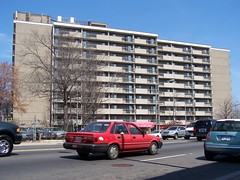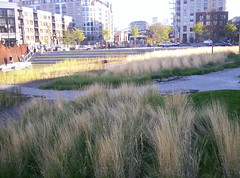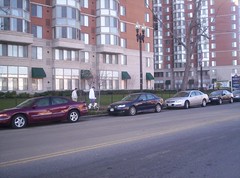Density and the future of the city
Thursday night there was a presentation about the appropriateness and seeming necessity of adding density to the city, specifically Washington, at the National Building Museum. I was not able to attend the presentation, having had an unbreakable commitment to attend a community planning meeting in Brookland.
According to renditions of the session on the historicwashington e-list, both Chris Leinberger and David Dixon spoke favorably of adding density, implying (or stating directly) about the reasonability of urban renewal like processes of demolishing lower dense neighborhoods in favor of higher density and mixed use.

Plex in Montreal (six units). Photo by Christopher DeWolf, Maisonneuve.
You can imagine that such a course sounds insane to a historic preservationist who sees thriving neighborhoods across the city, neighborhoods that in the great scheme of things are denser than typical suburban subdivisions, but compared to tower-based neighborhoods in Manhattan or Vancouver, British Columbia, or the bigger rowhouse buildings of Manhattan, Brooklyn, Boston, Cambridge, Montreal, and other cities, DC's rowhouse neighborhoods are less dense.

7th Street SE, Eastern Market. Photo by Keith Stanley.

A typical suburban subdivision is much less dense compared to a typical rowhouse neighborhood in the core of Washington, DC. New York Times photo. A typical DC block in the center city is larger than one acre, but one acre in a rowhouse neighborhood can accommodate about 40 15 to 17 foot-wide houses.
Granted, DC's neighborhood commercial districts tend to be less successful because the neighborhoods no longer have as much population as they did when such districts thrived (before 1945 when households were typically larger, and when having boarders, and extended family living situations were much more common).

Denser urban renewal junk constructed in the 1970s in the H Street NE neighborhood with financial support from the DC and federal governments. Another good example of such junk is Wah Luck House in "China"town. If anything, it contributed to the further diminishment of the presence of Asians in that neighbohrood.)
But unlike the Smart Growthers and DC's affordable housing activists, I don't think that paving our neighborhoods over for new and taller housing is an acceptable tradeoff. I think that in such an action, what makes the city unique, attractive, and livable will be destroyed.
In the session, David Dixon (of Goody Clancy) specifically said that historic preservation as a tool for managing design is no longer necessary, because architects and planners are now enlightened and put design quality foremost.
I can't think of anything less true, in my 7-8 years of very active community involvement.
Here is something I wrote in response to one of the postings:
Actually, Portland is a great model. Density isn't added to that city by tearing down extant neighborhoods and rebuilding them in the fashion of urban renewal. Density is being added by converting a railyard into a mixed use district (Pearl District). Density is being added by recovering the waterfront by removing a freeway, creating a park, and redeveloping some of the recovered area (the Riverplace District).

New park in the Pearl District, constructed as part of planned community amenities associated with new development.
I don't think we have areas quite as comparable, with the possible exception of RFK, the Stadium/M Street NE area, Florida Market (although I disagree with the City Council action of last December), and a couple others. However all of these areas are much smaller than the two above-mentioned districts in Portland.
Portland actually has much smaller city blocks than DC, 200x200, at least in the core of the city. And their maximum height for buildings is about like DC's, 160 feet.
Portland more than most cities (in my experience) would likely be aghast about destroying neighborhoods for higher density. There are few communities in the country with as strong a sense about livability and the value and importance of the public realm. They have a much finer and higher degree of appreciation about this than does DC, at least in my opinion.
However, and fortunately, DC's historic preservation laws are much stronger, because in the past some of Portland's neighborhoods have experienced demolition in favor of newer, discordant and denser buildings.
And as far as DC's population goes, I am in favor of the Brookings initiated endeavor to add population to the city. (See Rivlin Papers on Revitalizing DC Neighborhoods for an extended discussion of these issues.)
DC needs the tax revenue--income and property--given the structural conditions which limit DC's governmental revenue streams. But this population increase can be accommodated by better use of our land resources, without threatening the relatively low scale neighborhoods that define the livability of our community.
And it is in concert with pro-downtown living trends experienced in other strong market cities or strong market areas of cities such as Philadelphia, Brooklyn, and others. See this paper by Eugenie Birch, Who Lives Downtown?, which doesn't rate DC as highly as other center cities.
But certainly as pro-city people, we can see the residential housing activity in the East End and be buoyed, can't we? I think it's fantastic--seeing people walking their dogs on the 400 and 500 and 600 blocks of Mass Ave. NW, seeing people walking on 7th Street NE at all hours, having lines at the CVS at 7th and H Street NW (and the store has skilled, speedy clerks).

Dog walking on the 400 block of Massachusetts Avenue NW.
Furthermore, a point that needs to be accepted wrt DC's population is that yes, population at times is decreasing as larger households move out of the city, and are replaced by households at a different place in the household life cycle, when the household size is smaller, in large part due to not yet having children.
The fact is that the number of total households in the city is increasing, even if there is a debate on whether or not the population is increasing. And I think that people are making a mistake, by looking at the newly resident households in a static matter. These households are dynamic and population changes, as discussed in the previous blog entry.
Furthermore, although this is anecdotal, and less likely to be observed in neighborhoods like Foggy Bottom or Dupont Circle, and maybe Georgetown, there is a great and increasing number of younger aged DC households having children. This is especially visible in Greater Capitol Hill and Brookland, the neighborhoods in which where I spend most of my time.
One indicator would be a store like Dawn Price Baby on 7th Street SE. Another is the presence of children on blocks where I would never have guessed even five years ago--such as the 400 or 500 blocks of M Street NE.
The child in the photograph in the preceding blog entry, along with other children in strollers attended a walking tour of the Florida Market that I co-conducted last July. Shocked the hell out of me...
But at the same time, the problem of the schools must be addressed (even if I don't agree with the Mayor's proposals) or these families will move out of the city in time.
Labels: historic preservation, smart growth, urban revitalization



0 Comments:
Post a Comment
<< Home